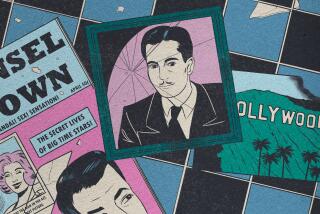News Often Has to Be Seen Before It Is Heard : Media: Television has created a revolution in the way the public responds to worldwide events.
One day last summer, Frank Mankiewicz, former press secretary to Sen. Robert F. Kennedy and now a public relations consultant in Washington, was discussing a client’s potential environmental pollution problem.
Based on what the man told him, Mankiewicz figured there were “no clouds of smoke that you can see come belching out of the smokestack, no oil-coated birds, no fish dying in the harbor.”
“Maybe we’re lucky,” Mankiewicz told the client. “There’s nothing visual here.”
Television, Mankiewicz says, is “very important” on stories like this--on virtually any story, in fact--precisely because of the power of visual images. Clear, dramatic pictures are the key to both “good television” and to the impact a given story will have on viewers.
The psychology of the news receiver is a complex process, involving repetition, the viewing environment, selective perception, preconceived biases and a variety of other factors. But as John Robinson and Mark Levy concluded in their book-length 1986 study of average television viewers, “The Main Source: Learning from Television News”:
“Vivid or concrete visual information is likely to be retained and remembered . . . to influence the inferences viewers draw about the news and thus their understanding of it.”
Newspapers periodically wrote investigative stories and indignant editorials about Pentagon overspending in the 1970s and early 1980s, but the issue didn’t really arouse much public interest until 1983, when television broadcast pictures of Caspar Weinberger, then secretary of defense, holding aloft an ordinary hammer for which the Pentagon had paid $435. The resultant coverage, in words and pictures, of similarly overpriced toilet seats, screwdrivers, bolts and bushings engendered widespread public outrage that helped push Congress to enact a law governing the procurement of spare parts.
Similarly, it took television photos of starving children in Somalia and emaciated men and women in Bosnian prison camps this year to finally force those stories into the American consciousness after earlier, sporadic coverage in a few newspapers was ignored by most of the media.
The impact of television’s visual imagery is especially powerful in politics--as Michael S. Dukakis found out when he ran for President in 1988.
Pictures of Dukakis in an Army tank elicited widespread public ridicule and came to be seen as symbolic of his misguided and doomed candidacy.
Public relations advisers, political spin doctors and others who make their living trying to manipulate the media are acutely aware of the power of the visual image. If the pictures are favorable, they almost don’t care what the words say.
Several Washington journalists noted during the Ronald Reagan Administration that they broadcast tough, critical stories on the President that were accompanied by film footage of him before cheering crowds, and the net impact was positive--pro-Reagan. As Sam Donaldson of ABC News puts it: “A simple truism about television (is that) the eye always predominates over the ear when there is a fundamental clash between the two.”
Long before television, in 1922, Walter Lippmann wrote: “Pictures have always been the surest way of conveying an idea”; for almost three decades, television has increasingly demonstrated the truth of that observation, so much so that many young people today can’t conceive of a time when television was not the primary source of news for most people.”
Now, 70 years after Lippmann’s words, it would be difficult to overstate the importance of television in conveying ideas and shaping public opinion.
“For most Americans, the world of public affairs exists primarily in the imagery of television news shows,” writes political scientist Shanto Iyengar of UCLA, author of the 1989 book “News That Matters: Television and American Opinion.”
“By attending to some problems and ignoring others, television news shapes the American public’s political priorities.”
Given the kinds of stories television tends to focus on--and the approach TV takes to those stories--Iyengar believes that television distorts the political process.
He calls this syndrome the “vividness bias.”
“The more vivid, the more colorful and the more episodic the message, the more likely people are to be distracted from systemic or beneath-the-surface kinds of diagnoses of problems,” he said in an interview.
Iyengar, who studies peoples’ responses to television stories and commercials, cites as an example the tendency of the media in general and television in particular in the 1980s to cover problems about the economy and poverty not as public policy stories but as human-interest stories.
Stories and pictures showing individual homeless and poor people remind viewers of “stereotypic attributes of poor people,” Iyengar says. “They tend to be seen as not having interest in employment, preferring to be on the dole.” That prompts grumbling about “individuals not doing enough” to help themselves, rather than prompting concern about the broader problems of unemployment, poverty and structural changes in the work force and the economy, he says.
It’s possible, of course, that television reinforces existing cultural and racial biases in many viewers; it’s also possible that some viewers react as Iyengar says because it just seems easier to blame individuals than to try to reform the entire economic system. Regardless, the impact of television in this process of personalization and oversimplification is incontrovertible.
Iyengar recognizes the Catch-22 inherent in this situation: Without vivid, concrete, visual examples, people may not pay any attention to an important issue; with vivid, concrete, visual examples, they may pay attention only to those examples.
“You get carried way by the details of the specifics,” he says. “You don’t get the big picture.”
For better or worse, though, there is widespread agreement that without television, few stories can have real impact these days.
Television “gives a story authority . . . a sense of power and . . . connectedness,” says Roger Fransecky, a Los Angeles psychologist and media consultant. “Print is abstract for many readers. It’s cool. It doesn’t resonate with their experience.”
Major newspapers generally break the big stories, but it’s usually television that gives them impact, bounce--”legs” in the jargon of Hollywood.
“Television . . . frequently takes its cue from what some of the larger newspapers decide is news,” says Dan Rather, anchor and managing editor of the “CBS Evening News.” But if a story is to “take traction . . . to have impact and particularly to have staying power . . . somebody in national television has to be willing to devote the resources and time to it.”
This is, of course, a matter of immediacy and impact. Television often takes viewers to the scene of a news story in progress; as all-news radio has also shown, such real-life, real-time drama can be extraordinarily powerful, even without pictures.
“Television leads the way,” says William Hilliard, editor of the Portland Oregonian. “It has such an impact on the American people (because) it crosses racial, cultural and ethnic borders. If television gives a story big play, people talk about it and newspapers jump on it.”
More to Read
The complete guide to home viewing
Get Screen Gab for everything about the TV shows and streaming movies everyone’s talking about.
You may occasionally receive promotional content from the Los Angeles Times.






